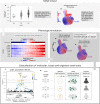This is a preprint.
Identifying genetic variants that influence the abundance of cell states in single-cell data
- PMID: 38014313
- PMCID: PMC10680752
- DOI: 10.1101/2023.11.13.566919
Identifying genetic variants that influence the abundance of cell states in single-cell data
Update in
-
Identifying genetic variants that influence the abundance of cell states in single-cell data.Nat Genet. 2024 Oct;56(10):2068-2077. doi: 10.1038/s41588-024-01909-1. Epub 2024 Sep 26. Nat Genet. 2024. PMID: 39327486 Free PMC article.
Figures




References
-
- Yazar S. et al. Single-cell eQTL mapping identifies cell type–specific genetic control of autoimmune disease. Science 376, eabf3041 (2022). - PubMed
Publication types
Grants and funding
LinkOut - more resources
Full Text Sources
